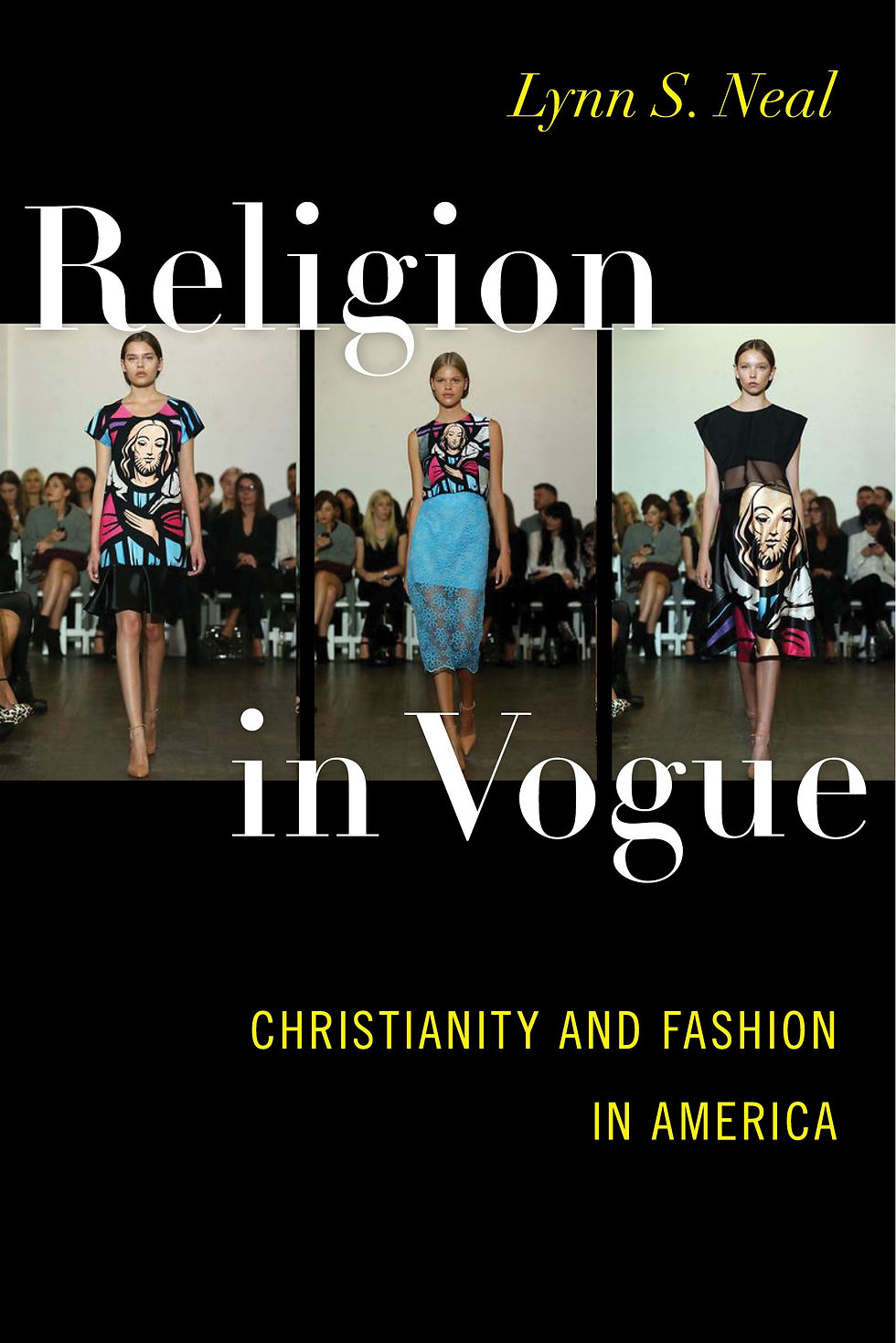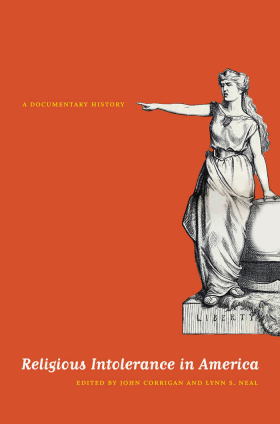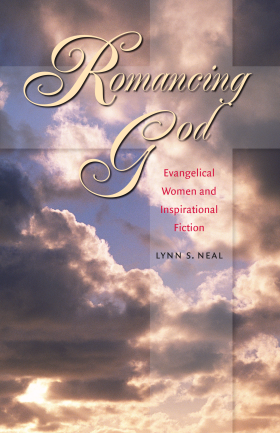Publications
Monographs



December 17, 2019
Religion in Vogue: Christianity and Fashion in America
Taking fashion as its starting point, Religion in Vogue provides readers with a unique approach to the study of popular culture and American religion. Through its analysis of numerous primary sources ranging from fashion magazines to runway shows, the book traces how Christian symbols and imagery became an increasingly prominent part of the fashion industry and designer apparel. Examining this trajectory illuminates the longstanding and evolving relationship between Christianity and fashion.
May 10, 2010
Religious Intolerance in America: A Documentary History
In the first ever documentary survey of religious intolerance from the colonial era to the present, volume editors John Corrigan and Lynn S. Neal define religious intolerance and explore its history and manifestations, including hate speech, discrimination, incarceration, expulsion, and violence. Organized thematically, the volume combines the editors' discussion with more than 150 striking primary texts and pictures that document intolerance toward a variety of religious traditions. Stay tuned for a new revised and expanded edition in Spring 2020!
December 8, 2006
Romancing God: Evangelical Women and Inspirational Fiction
In the world of the evangelical romance novel, sex and desire are mitigated by an omnipresent third party--the divine. Thus romance is not just an encounter between lovers, but a triangle of affection: man, woman, and God. Although this literature is often disparaged by scholars and pastors alike, inspirational fiction plays a unique and important role in the religious lives of many evangelical women.
Publications
Peer-Reviewed Articles and Book Chapters
January 4, 2019
Religion Reprocessed in Dolce & Gabbana's 'Tailored Mosaic'
This book chapter appears in Fashion and Contemporaniety, edited by Laura Petican and published by Brill. It examines Dolce and Gabbana’s 2013 line ‘Tailored Mosaic,' which captured the attention of the fashion world through its exquisite craftsmanship and religious content. Inspired by the Cathedral of Monreale in Sicily, the design duo’s runway show featured garments printed with images from Monreale’s mosaics, while others were made from beautiful lace and rich tweeds, and still others contained versions of the mosaics crafted through intricate beadwork and embroidery. The collection garnered praise and once again raised the question of religion’s relationship to fashion. Often the use of religion in fashion is meant to shock and provoke; however, the use of religious symbols in ‘Tailored Mosaic’ elicited praise and admiration. What made this collection different? Why did it capture the attention of so many people? This chapter focuses on ‘Tailored Mosaic’ as a way to examine the dynamic relationship between religion and fashion. Questioning the common interpretive framework that portrays religion and fashion as foes battling for supremacy, this chapter analyses how religion is reprocessed in and through fashion. By utilizing this approach, I show how interpretations of the designers’ biographies and intentions enhanced the success of ‘Tailored Mosaic’ and its vision of religion as defined by beauty and grandeur, as well as history and politics.
November 2018
Jonestown on Television
This media review essay adds to existing scholarship about Peoples Temple by examining Jonestown’s presence in television history—from 1980 when actor Powers Boothe won an Emmy Award for his portrayal of Jim Jones in the CBS-TV movie Guyana Tragedy: The Story of Jim Jones to current programs in production by HBO and A&E. In addition to these docudramas, “Jonestown on Television” also addresses explicit and implicit references to Jonestown that have occurred on episodic television. Analyzing these television sources highlights how the events at Jonestown are being told, visualized, and remembered, and, as such, shaping Americans’ cultural memory of the past.
March 9, 2016
OMG: Authenticity, Parody, and Evangelical Christian Fashion
This article analyzes the relationship between religion and fashion through an examination of evangelical t-shirts. It demonstrates how Christian companies attempt to authenticate their t-shirt apparel through origin stories, text and graphics, and model styling. However, this authentication process does not go uncontested. For example, the t-shirts and tanks created by Heart OMG resemble “authentic” evangelical tees in some ways, but not in others, which has caused some to question the company’s products and motives. The article turns to the concept of parody to help illuminate Heart OMG’s status. Companies such as Amazing Atheist Tees and Reasonist Products parody evangelical tees to criticize religion and make their own atheist views known. Other parodies of evangelicalism attempt to construct a sense of “cool” and transgression through their garments. Examining parody and these various spin-offs of the evangelical t-shirt highlights the influence of religion in fashion, as well as the enduring power and contested character of authenticity.
April 29, 2015
The Ideal Democratic Apparel: T-shirts, Religious Intolerance, and the Clothing of Democracy
Studies of clothing highlight the power of fashion and the ways dominant groups police deviant fashion; however, they neglect to analyze how a mainstream fashion item, the T-shirt, also helps monitor the boundaries and norms of American society. This article examines the relationship between the T-shirt form and religious intolerance. Scholars have analyzed nativist rhetoric, polemical literature, and caricatured renderings, yet clothing as a site of religious conflict remains understudied. To address these scholarly gaps, this article first investigates the history and meanings of the T-shirt, and then presents a case study of religious intolerance focused on Islamophobic T-shirts. This analysis builds toward an understanding of the T-shirt as the ideal article of democratic apparel for disseminating religious intolerance. In the end, we see how these T-shirts refashion religious intolerance as American individualism, thus perpetuating the idea that religious intolerance is only an occasional accessory to, rather than a constituent part of the clothing of, American democracy.
February 2011
"'They're Freaks!': The Cult Stereotype in Fictional Television Shows, 1958-2008"
This article analyzes the stereotypical portrayal of cults on fictional television shows and demonstrates the vital role that this popular culture form plays in the dissemination of anticult ideology. Through an in-depth examination of five episodes that aired between 1998 and 2008, it delineates how these shows employed stereotypical cult elements, such as fraud and violence, as well as contrasts in clothing, setting, and lifestyle to differentiate conventional religion from the dangers and delusions of cults. Further, the article reveals how usage of the cult concept is not limited to the present context and documents the pervasiveness of the cult stereotype on television since 1958. By highlighting these patterns, this study shows the power and implications of the cult stereotype. It illuminates how these television shows constitute a powerful force in defining and policing the boundaries of religious legitimacy in American culture. See Nova Religio 14:3 (February 2011): 81-107.